by Lem Bingley 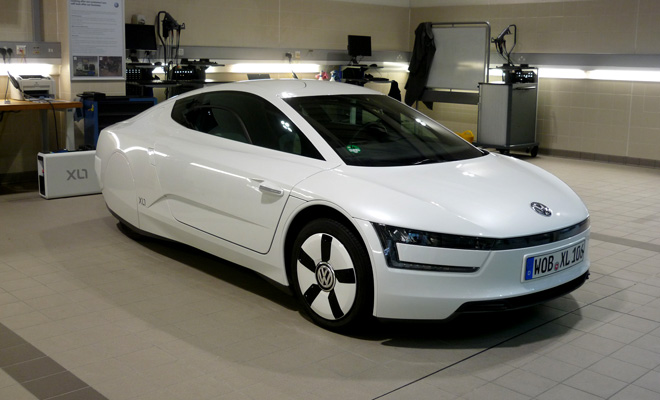
Inside, the car doesn’t feel quite as cramped as the exterior might suggest. You sit in a sports-car position, more bathtub than armchair, on a thinly padded seat that dictates a fixed angle between your thighs and spine (though you can pitch the whole seat up and down a bit). Getting adjusted feels distinctly unusual but the result is comfortable enough.
You wouldn’t describe the XL1 as spacious unless you normally relax in a coffin, but the staggered seating arrangement – which places the passenger a foot further back than the driver – helps to prevent elbows knocking.
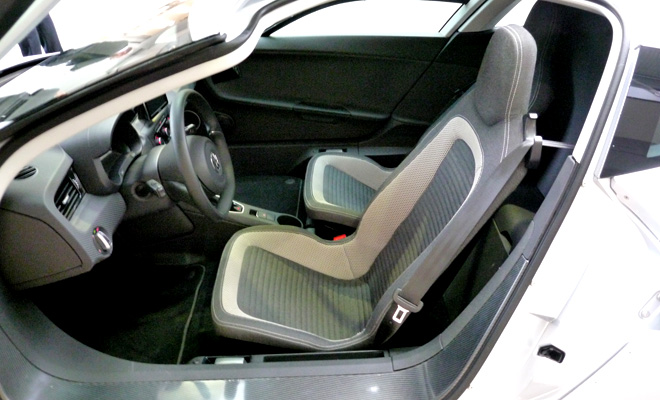
And you will need to swing your arms. On the move, one of the most noticeable facets of the XL1 driving experience is the complete lack of power steering. The force needed to turn the small, flat-bottomed wheel is unusually firm, especially at low speed, away from the centre line. When carving into corners at middling speeds it can sometimes feel as if the XL1 is understeering, though this result is not through any lack of grip from the narrow eco tyres, but the simple need for harder work at the wheel.
Of course the XL1’s name is nothing to do with its size, instead referencing its status as an experimental 1-litre car – measured in fuel economy terms rather than cubic capacity. One litre per 100km equates to about 282mpg, though the car has managed to trump that project goal, achieving 0.9 litres per 100km under the combined cycle test, or about 313mpg, and just 21g/km in CO2 terms. Unofficially, I’m told even that result has been rounded up from an even better 0.83l/100km (340mpg).

All of which are nonsense numbers anyway, since the XL1 is a plug-in hybrid electric car, relying on mains electricity to achieve a battery-only range of about 30 miles, or using stored power to supplement the 0.8-litre, two-cylinder diesel engine in hybrid fashion. And since you can’t carry electrons in a bucket, I’m not a fan of gallon-based measures for cars that come with a plug. Your mileage will vary considerably according to how often you drive beyond the point where the 5.5kWh lithium ion battery runs out of initial charge – though outcomes will probably still land on the far side of 120mpg.
And when I say “your mileage” it really could be you, given that VW is putting the XL1 into limited production. In all, 200 customer cars will be built, plus 50 prototypes, some of which may be offered second-hand. The UK will get perhaps 20 cars, all left-hand drive. But it might be handy to win the lottery first, as the European price has been set at a challenging €111,000 or about £94,000.

You do get a bit of drama for your money. Bend down, pop your fingers through the letterbox slot of the door handle, and you can lift the big clamshell door upwards, in supercar style. There’s also the kudos of a carbon-fibre and aluminium structure, though the black weave on the dashboard and steering wheel is apparently not the real thing.
Clamber aboard, slam the door shut – the lightweight structure swings down easily against its gas struts – and take note of the bright alloy door release down at sill level. A small red warning lamp ahead of the handle will glow brightly if the explosive bolts are armed. Yes, in the unlikely event that your driving lands you on your roof, the doors will need to be jettisoned, as they won’t budge when upside down and you’ll struggle to slip out of the elbow-sized side windows unless you’re a direct descendent of Harry Houdini.
Press the starter button and you’re good to go – in silent electric stealth mode if you wish. One of the few buttons on the sparse centre console selects EV mode, which will rely on the 20kW (27bhp) motor and keep the engine quiet unless you floor the throttle. There’s no external warning noise, so unwary pedestrians may need to be hooted at.

If you do stamp on the throttle, pushing past the kink in its travel designed to dissuade, the 48PS (47bhp) diesel unit will spring into noisy action behind your head, as peaceful as a spadeful of gravel in a washing machine.
There’s clearly not much soundproofing between the engine bay and the cabin, though the clatter is only really intrusive at low speed, and only then because it arrives in unsubtle contrast to the utter silence of electric propulsion. At higher speeds, once tyre and wind noise has built up a little, you can barely hear the engine cutting in and out as it does its hybrid stuff.
The electric motor is mounted between the engine and gearbox, with all drive channelled through to the rear wheels. A clutch between the two power sources allows the XL1 to effectively put the engine to one side when not running it, though the electric motor is permanently hooked up to the gearbox.
Aside from the EV button there’s not much for the driver to juggle when driving. The seven-speed, dual-clutch transmission makes changes smoothly and unobtrusively, and can’t be overruled manually. The gear lever does toggle between “D” and “S” modes on the move, which roughly speaking are suited to highway and city driving respectively.
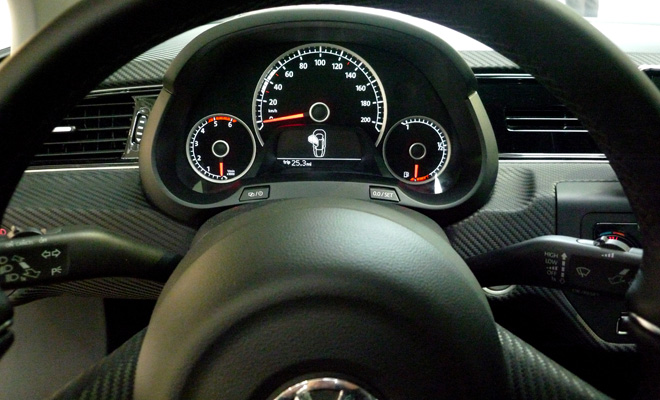
In D, the gearbox will open both its clutches when you lift off the throttle – allowing a gliding or coasting sensation that is also offered by automatic versions of the current VW Golf. Of course the slippery XL1, with an eel-like drag factor of 0.189, makes even the wind-cheating new Golf feel as if it’s towing a huge parachute.
Set to S, the electric motor will stay coupled to the wheels as you lift off the throttle, creating a gentle engine-braking effect that is actually energy recuperation. Much of the energy of the car’s momentum is caught and funnelled back into the battery as it slows, which also happens when braking at up to about 20% effort. For sharper stopping, the car’s ceramic discs make a noisy, grinding contribution to shedding speed. Taken overall, the brakes feel surprisingly normal and reassuringly progressive.
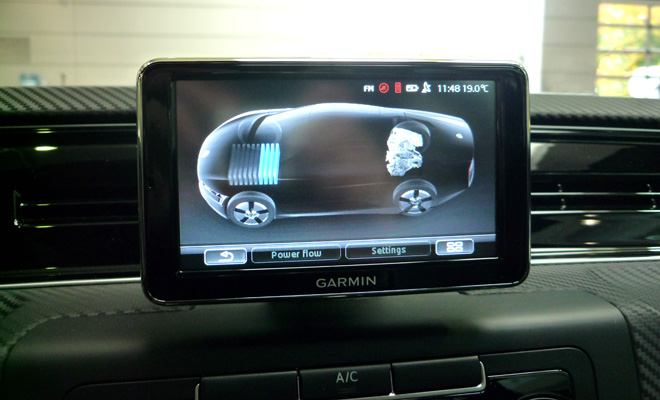
A lift-out central screen unit, similar to that found in the humble VW Up, provides a selection of animated graphics to keep you informed about the various power flows from wheels to battery, or vice versa, and energy moving from engine to wheels or engine to battery. It also serves the more helpful purpose of satellite navigation.
And speaking of the Up, it’s interesting to note that the XL1’s plug-in hybrid powertrain will apparently fit under the Up’s truncated bonnet. I’m told the result would likely be a two-litre (141mpg) city car.
Any future plug-in Up would of course be much less slippery than the XL1 and not as light, though it would be more practical with two extra seats. It also would probably carry around its own charger. The XL1 comes with a suitcase-sized box of electronics that slots between your mains supply and a charging socket on the car’s flank. The charger has been left out for reasons of weight and luggage space, though apparently it will fit in the boot if you want to recharge en route – though of course the XL1 can carry on indefinitely without plugging in, if you fill up the 10-litre tank every 300 miles or so.
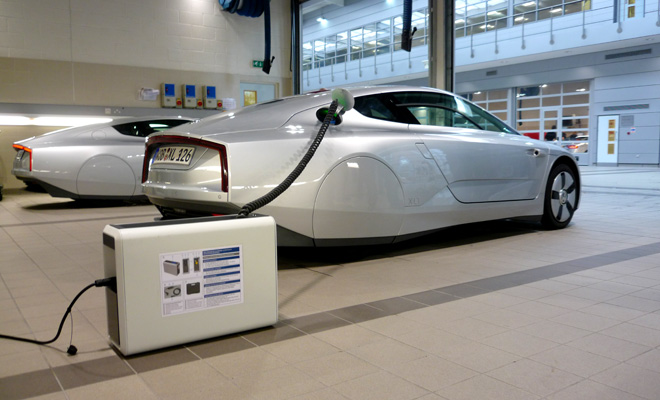
On the road, there’s plenty of visibility ahead and to the sides, courtesy of slim screen pillars, though the unusually low viewpoint will feel arresting if you’ve just stepped out of an SUV. Rear vision is unnervingly absent, and with no mirrors at all it’s down to a pair of cameras, about two feet off the ground on each side, to provide a lowdown view via twin monitors mounted in the doors. These mimic curved, blindspot-eliminating door mirrors by giving a compressed view at their outer edges. No doubt you’d adjust in time but to begin with it can feel difficult to confidently judge lane-changing gaps in bustling traffic. Fortunately, people tend to make way for the XL1 on account of its resemblance to a freshly landed UFO.
The 200 production cars may gain a third camera, mimicking a central rear-view mirror, to eliminate a modest blind spot dead astern.

I suspect the need to carefully control airflow under the car, for aerodynamic efficiency, is why the XL1 comes fitted with suspension as softly sprung as a shopping trolley. Lumps, bumps and potholes shimmy straight through to the cabin, in jaw-jarring sports-car fashion.
Not that the XL1 ever feels sporty. The chassis remains resolutely flat through bends but the performance on offer is never more than adequate. The car can handle everything from urban nippiness to motorway overtaking, but it isn’t quick, as the 12.7-second dash to 62mph makes clear. Top speed is also capped at 99mph in the interests of economy, though a derestricted car might hit 125mph.
Climbing out of the car, over its wide, high-set carbon sill, you might easily conclude that the XL1 is not very good. It’s expensive, cramped, impractical, slow, noisy and hard riding. But judged in the context of what it’s actually designed to do, it’s hard not to be won over by its single-minded, fanatical devotion to the business of saving fuel.
Isolated in its own frame of reference, the XL1 is simply breathtaking. It feels as seductively desirable as any other pure, precision tool. It’s like a Sabatier knife for the road.


Volkswagen XL1
Rating: stars
Good: Incredibly frugal and built with obvious precision
Bad: Cramped, noisy, impractical, slow and expensive
Price: €111,000 (about £94,000)
It’s ironic that Volkswagen has chosen to call its most frugal car the XL1, given that extra-large is the one thing it’s not. Photographs don’t quite convey how narrow, delicate and incredibly low the vehicle is when confronted in reality. It’s about knee-high to an MX-5. Rating: stars
Good: Incredibly frugal and built with obvious precision
Bad: Cramped, noisy, impractical, slow and expensive
Price: €111,000 (about £94,000)
Inside, the car doesn’t feel quite as cramped as the exterior might suggest. You sit in a sports-car position, more bathtub than armchair, on a thinly padded seat that dictates a fixed angle between your thighs and spine (though you can pitch the whole seat up and down a bit). Getting adjusted feels distinctly unusual but the result is comfortable enough.
You wouldn’t describe the XL1 as spacious unless you normally relax in a coffin, but the staggered seating arrangement – which places the passenger a foot further back than the driver – helps to prevent elbows knocking.

And you will need to swing your arms. On the move, one of the most noticeable facets of the XL1 driving experience is the complete lack of power steering. The force needed to turn the small, flat-bottomed wheel is unusually firm, especially at low speed, away from the centre line. When carving into corners at middling speeds it can sometimes feel as if the XL1 is understeering, though this result is not through any lack of grip from the narrow eco tyres, but the simple need for harder work at the wheel.
Of course the XL1’s name is nothing to do with its size, instead referencing its status as an experimental 1-litre car – measured in fuel economy terms rather than cubic capacity. One litre per 100km equates to about 282mpg, though the car has managed to trump that project goal, achieving 0.9 litres per 100km under the combined cycle test, or about 313mpg, and just 21g/km in CO2 terms. Unofficially, I’m told even that result has been rounded up from an even better 0.83l/100km (340mpg).

All of which are nonsense numbers anyway, since the XL1 is a plug-in hybrid electric car, relying on mains electricity to achieve a battery-only range of about 30 miles, or using stored power to supplement the 0.8-litre, two-cylinder diesel engine in hybrid fashion. And since you can’t carry electrons in a bucket, I’m not a fan of gallon-based measures for cars that come with a plug. Your mileage will vary considerably according to how often you drive beyond the point where the 5.5kWh lithium ion battery runs out of initial charge – though outcomes will probably still land on the far side of 120mpg.
And when I say “your mileage” it really could be you, given that VW is putting the XL1 into limited production. In all, 200 customer cars will be built, plus 50 prototypes, some of which may be offered second-hand. The UK will get perhaps 20 cars, all left-hand drive. But it might be handy to win the lottery first, as the European price has been set at a challenging €111,000 or about £94,000.

You do get a bit of drama for your money. Bend down, pop your fingers through the letterbox slot of the door handle, and you can lift the big clamshell door upwards, in supercar style. There’s also the kudos of a carbon-fibre and aluminium structure, though the black weave on the dashboard and steering wheel is apparently not the real thing.
Clamber aboard, slam the door shut – the lightweight structure swings down easily against its gas struts – and take note of the bright alloy door release down at sill level. A small red warning lamp ahead of the handle will glow brightly if the explosive bolts are armed. Yes, in the unlikely event that your driving lands you on your roof, the doors will need to be jettisoned, as they won’t budge when upside down and you’ll struggle to slip out of the elbow-sized side windows unless you’re a direct descendent of Harry Houdini.
Press the starter button and you’re good to go – in silent electric stealth mode if you wish. One of the few buttons on the sparse centre console selects EV mode, which will rely on the 20kW (27bhp) motor and keep the engine quiet unless you floor the throttle. There’s no external warning noise, so unwary pedestrians may need to be hooted at.

If you do stamp on the throttle, pushing past the kink in its travel designed to dissuade, the 48PS (47bhp) diesel unit will spring into noisy action behind your head, as peaceful as a spadeful of gravel in a washing machine.
There’s clearly not much soundproofing between the engine bay and the cabin, though the clatter is only really intrusive at low speed, and only then because it arrives in unsubtle contrast to the utter silence of electric propulsion. At higher speeds, once tyre and wind noise has built up a little, you can barely hear the engine cutting in and out as it does its hybrid stuff.
The electric motor is mounted between the engine and gearbox, with all drive channelled through to the rear wheels. A clutch between the two power sources allows the XL1 to effectively put the engine to one side when not running it, though the electric motor is permanently hooked up to the gearbox.
Aside from the EV button there’s not much for the driver to juggle when driving. The seven-speed, dual-clutch transmission makes changes smoothly and unobtrusively, and can’t be overruled manually. The gear lever does toggle between “D” and “S” modes on the move, which roughly speaking are suited to highway and city driving respectively.

In D, the gearbox will open both its clutches when you lift off the throttle – allowing a gliding or coasting sensation that is also offered by automatic versions of the current VW Golf. Of course the slippery XL1, with an eel-like drag factor of 0.189, makes even the wind-cheating new Golf feel as if it’s towing a huge parachute.
Set to S, the electric motor will stay coupled to the wheels as you lift off the throttle, creating a gentle engine-braking effect that is actually energy recuperation. Much of the energy of the car’s momentum is caught and funnelled back into the battery as it slows, which also happens when braking at up to about 20% effort. For sharper stopping, the car’s ceramic discs make a noisy, grinding contribution to shedding speed. Taken overall, the brakes feel surprisingly normal and reassuringly progressive.

A lift-out central screen unit, similar to that found in the humble VW Up, provides a selection of animated graphics to keep you informed about the various power flows from wheels to battery, or vice versa, and energy moving from engine to wheels or engine to battery. It also serves the more helpful purpose of satellite navigation.
And speaking of the Up, it’s interesting to note that the XL1’s plug-in hybrid powertrain will apparently fit under the Up’s truncated bonnet. I’m told the result would likely be a two-litre (141mpg) city car.
Any future plug-in Up would of course be much less slippery than the XL1 and not as light, though it would be more practical with two extra seats. It also would probably carry around its own charger. The XL1 comes with a suitcase-sized box of electronics that slots between your mains supply and a charging socket on the car’s flank. The charger has been left out for reasons of weight and luggage space, though apparently it will fit in the boot if you want to recharge en route – though of course the XL1 can carry on indefinitely without plugging in, if you fill up the 10-litre tank every 300 miles or so.

On the road, there’s plenty of visibility ahead and to the sides, courtesy of slim screen pillars, though the unusually low viewpoint will feel arresting if you’ve just stepped out of an SUV. Rear vision is unnervingly absent, and with no mirrors at all it’s down to a pair of cameras, about two feet off the ground on each side, to provide a lowdown view via twin monitors mounted in the doors. These mimic curved, blindspot-eliminating door mirrors by giving a compressed view at their outer edges. No doubt you’d adjust in time but to begin with it can feel difficult to confidently judge lane-changing gaps in bustling traffic. Fortunately, people tend to make way for the XL1 on account of its resemblance to a freshly landed UFO.
The 200 production cars may gain a third camera, mimicking a central rear-view mirror, to eliminate a modest blind spot dead astern.

I suspect the need to carefully control airflow under the car, for aerodynamic efficiency, is why the XL1 comes fitted with suspension as softly sprung as a shopping trolley. Lumps, bumps and potholes shimmy straight through to the cabin, in jaw-jarring sports-car fashion.
Not that the XL1 ever feels sporty. The chassis remains resolutely flat through bends but the performance on offer is never more than adequate. The car can handle everything from urban nippiness to motorway overtaking, but it isn’t quick, as the 12.7-second dash to 62mph makes clear. Top speed is also capped at 99mph in the interests of economy, though a derestricted car might hit 125mph.
Climbing out of the car, over its wide, high-set carbon sill, you might easily conclude that the XL1 is not very good. It’s expensive, cramped, impractical, slow, noisy and hard riding. But judged in the context of what it’s actually designed to do, it’s hard not to be won over by its single-minded, fanatical devotion to the business of saving fuel.
Isolated in its own frame of reference, the XL1 is simply breathtaking. It feels as seductively desirable as any other pure, precision tool. It’s like a Sabatier knife for the road.




